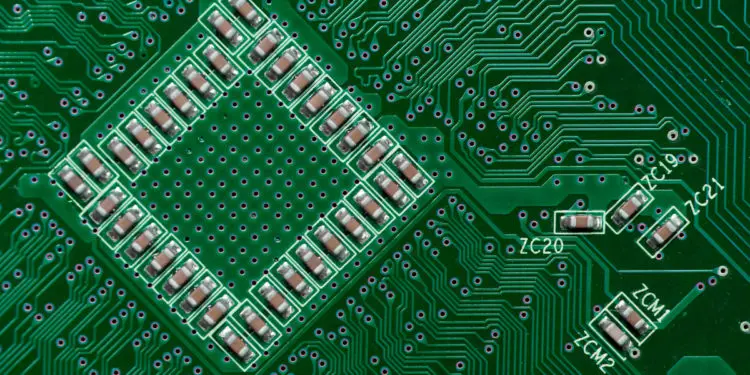by: D.Zogbi, Paumanok Inc. Published by TTI MarketEye
Multilayered ceramic chip capacitors (MLCCs) have been in short supply for 24 months, and the outlook for consumption continues to create uncertainty about market conditions for the final quarter of the calendar year. This TTI MarketEYE article looks at the current market health for seven sub-types of MLCCs as we go into the final quarter of 2019.
How Have Lead Time Trends Evolved?
Overall, capacitor lead times declined sharply in October 2019 on a month-to-month basis due to a significant drop in demand for picofarad type MLCCs (i.e. <1 µF). However, high-capacitance BME type MLCC (2.2 to 1,000 µF) remain an area of concern up and down the supply chain.
Lead times for large-capacitance base metal electrode MLCCs were unchanged on a month-to-month basis in September and October, and the market for MLCCs above 47 microfarads remains tighter than all 29 other capacitor component segments. This is most likely due to expected demand from 5G base stations and next-generation 5G phones.
In addition, the demand for high reliability and specialty ceramic capacitors, especially high voltage + high capacitance types for electric vehicles, is expected to be significant.
The supply chain disruption of the past 24 months, modelled here, shows how the recent bubble developed by MLCC type and case size, and how the market is faring in its return to the normal supply-and-demand balances that had been evident in the market for the preceding 75 months.
The following is a visual interpretation of data collected by Paumanok Publications, Inc. that clearly shows the overall market for MLCCs decreased substantially from May 2019 through October 2019, with a substantial decline in value from September 2019 to October 2019. Picofarad MLCCs continued to decline while high-cap BME MLCC types have levelled off.
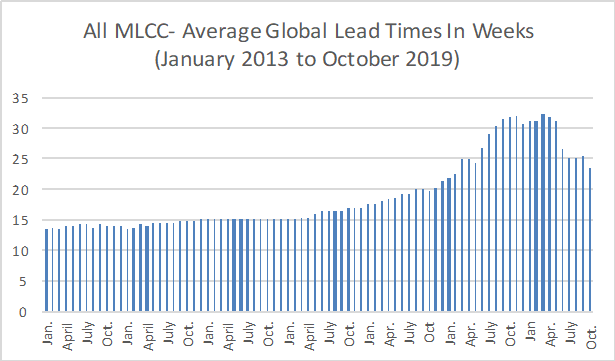
Picofarad-Type MLCCs
The following chart illustrates lead time data for picofarad type MLCCs, or the low-layer count, low-capacitance value MLCCs usually available in the NPO or low capacitance X7R chemistries below one microfarad:
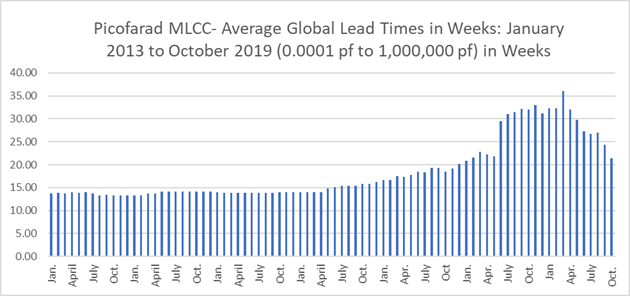
Microfarad-Type MLCCs
The chart below illustrates lead-time data for microfarad-type MLCCs, or high-layer count chip capacitors with base metal electrodes, available in the X5R or X7R chemistries above one microfarad.
This range of high-capacitance MLCC now includes 220, 330, 470, 680 and 1,000 microfarad parts. This product range is manufactured from ceramic dielectric materials in a stacked dielectric and electrode configuration, and terminated with solderable metal endcaps.
In this category only, all electrodes are nickel and all terminations are copper. These MLCCs are used for bypass, decoupling and filtering in all product lines and are the enabling technology for portability in handsets and computer tablets.
The demand for high-capacitance MLCCs as a collective unit has seen consistent and consecutive growth since January 2017. The market remains tight in October 2019; demand here may continue to increase and act counter to the market due to the global trend toward higher capacitance signature per box, especially as it relates to cars, handsets, base stations and the internet of things.
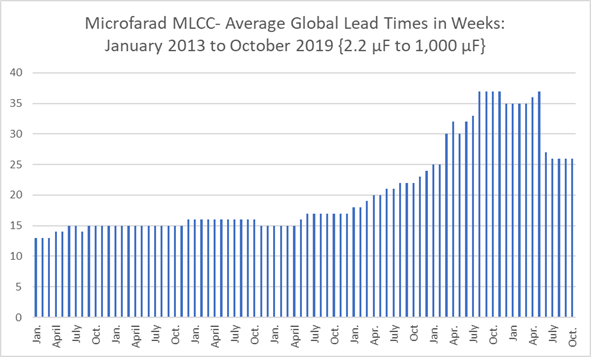
High-Reliability MLCCs
The following chart includes high-reliability MLCCs in all types and constructions, including barium titanate and porcelain ceramic dielectrics that are fabricated almost exclusively with precious metal electrodes and terminations.
This is a basket category of all ceramic capacitors in chip, axial and radial leaded configurations, including product lines consumed in value-added and application specific end-use markets in infrastructure, oil and gas, defense and medical electronics segments (to include detonator capacitors, safety capacitors and tip and ring capacitors).
Demand for specialty ceramic capacitors began to increase in value in late 2017 and has continued to increase in 2018 and 2019 due to strong demand from the space electronics and medical market segments. Demand here has doubled in value since 2016, due in part to the repurposing of specialty capacitors to commercial markets in order to take advantage of the higher prices being paid by the consumer AV and computer mainstream segments.
This segment utilizes precious metal electrodes and terminations almost exclusively, but manufacturers are now moving more firmly toward the adoption of base metals in FY 2020.
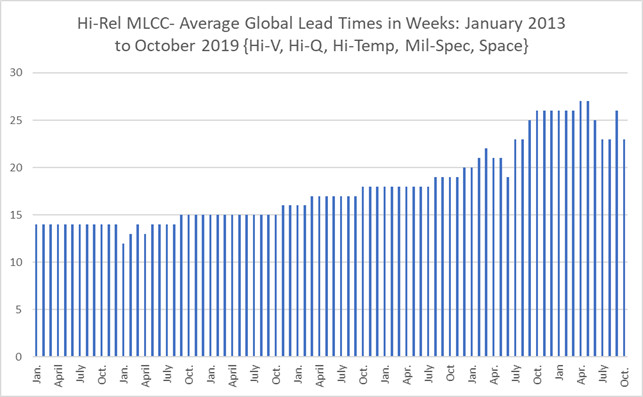
Lead Times, October 2019 Onward
In October of 2019, lead times continue to weaken for picofarad-type MLCCs and high-reliability MLCCs, while lead times for high capacitance BME-type MLCCs have levelled off and are acting counterintuitively to the rest of the market due to underlying shortages of vendors who can produce extremely high capacitance chips above 100 microfarad.
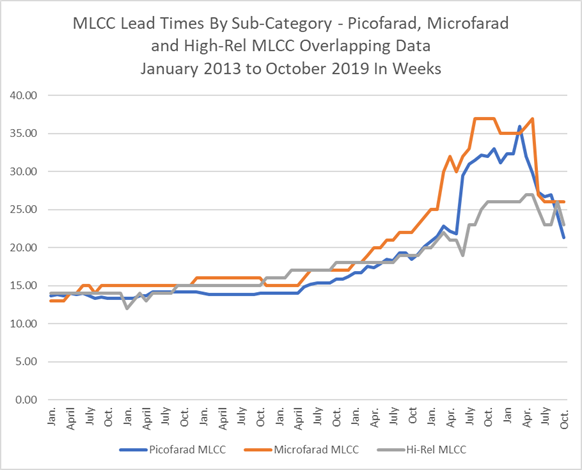
MLCC Supply Chain Trends by Case Size
In this segment, we look at shortages of MLCCs based on case size in an attempt to help the reader understand that, since this technology involves three-dimensional stacking of interleafing layers of ceramic and metal, the shortage by case size is really a larger shortage of stacking capability.
In a shortage of parts, end-markets compete with each other for supply due to the ubiquitous nature of the part in all electronic circuits. Not only does such a shortage affect all MLCC case sizes; it affects peripheral markets and like dielectrics as well.
Ceramic 0201 MLCC (Chips (0201 BaTI02)
This MLCC has the physical dimension of 0.02 x 0.01 inches and is extremely small, no bigger than a grain of salt. This product is manufactured from ceramic dielectric materials in a stacked dielectric and electrode configuration and terminated with solderable metal endcaps.
This product enables portable technology and is largely consumed in wireless handsets and enables module circuitry. It is used for bypass, decoupling, filtering and is a ubiquitous product line, produced worldwide in the hundreds of billions of pieces.
The shortage in the 0201 MLCC markets began in April of 2016, but compounded in April of 2017 and peaked in August of 2018. In October of 2019, demand remains elevated but steadily returning to prior levels of stable supply and demand, as weakness in the handset business has disrupted basic demand. The outlook for this case size remains favorable for 5G handset consumption in camera, power and antenna modules.
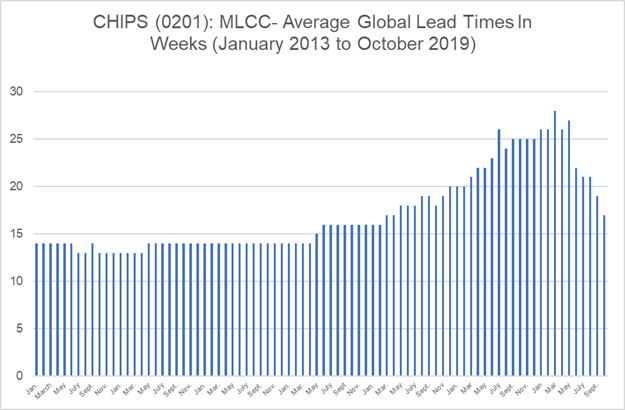
Ceramic 0402 MLCC (Chips (0402 BaTI02)
This MLCC has a physical dimension of 0.04×0.03 inches and is extremely small. This product is manufactured from ceramic dielectric materials in a stacked dielectric and electrode configuration and terminated with solderable metal endcaps.
This product enables portable technology and is largely consumed in wireless handsets and enables module circuitry. It is used for bypass, decoupling, filtering and is a ubiquitous product line, produced worldwide in the hundreds of billions of pieces. It is the largest mass produced part in the world.
Paumanok estimates the 0402 MLCC market to be the largest passive component market sub-segment of all products. This segment’s market value has more than doubled in size between October of 2016 and October of 2019. Demand is now decreasing for this product line in the December 2019 quarter as capacity expansion fills the void, while demand from handsets and computers remains lackluster. The outlook for this case size remains favorable for 5G handset consumption in camera, power and antenna modules.
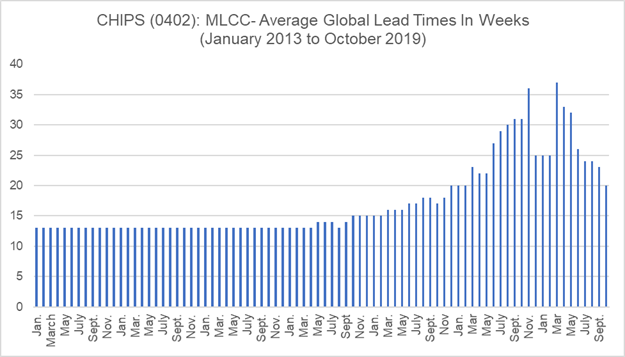
Ceramic 0603 MLCC (Chips (0603 BaTI02)
This very small MLCC has physical dimensions of 0.06 x 0.03 inches. This product is manufactured from ceramic dielectric materials in a stacked dielectric and electrode configuration and terminated with solderable metal endcaps.
This product is used in many circuits, but is generally too large for today’s modern handsets. It is used for bypass, decoupling, and filtering, and is a ubiquitous product line produced worldwide in the hundreds of billions of pieces. End-markets for the 0603 include in automotive, industrial and computer equipment.
Demand for 0603 MLCCs began to increase in October of 2016 and peaked in March of 2019. The market has relaxed substantially in October 2019, but has also doubled in market value during this time period. The 0603 is used in computers, automobiles and industrial end-use markets where voltage requirements are higher than those of handsets.
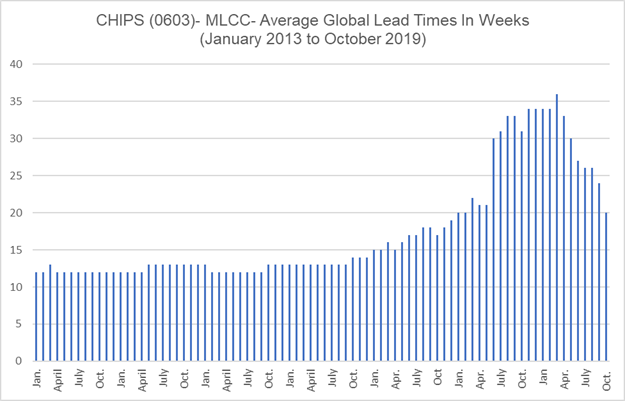
Ceramic 0805 MLCC (Chips (0805 BaTI02)
This very small MLCC has physical dimensions of 0.08 x 0.05 inches. This product is manufactured from ceramic dielectric materials in a stacked dielectric and electrode configuration and terminated with solderable metal endcaps. It is used for bypass, decoupling and filtering and is a ubiquitous product line, produced worldwide in the hundreds of billions of pieces. End-markets include automotive, industrial and computer equipment.
Demand for 0805 MLCCs began to increase in October of 2016 and peaked in March of 2019. The market had relaxed substantially by October 2019, but has also doubled in global market value during this time-period. 0805 MLCCs are considered “large case size” and truly in short supply. Capacity expansion in the global supply chain has eased supply constraints affecting automotive, lighting and power customers.
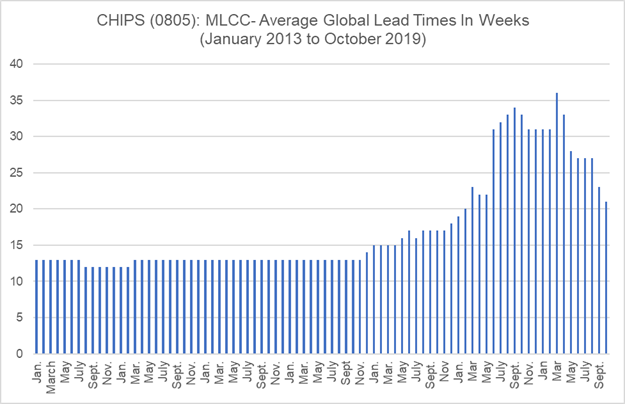
Ceramic 1206 MLCC (Chips (1206 BaTI02)
This very small MLCC has physical dimensions of 0.12 x 0.06 inches. This product is manufactured from ceramic dielectric materials in a stacked dielectric and electrode configuration and terminated with solderable metal endcaps. It is used for bypass, decoupling and filtering, and is a ubiquitous product line produced worldwide in the tens of billions of pieces. End-markets for these MLCCs include automotive and industrial.
1206 MLCC demand began to increase in October of 2017, then really spiked in March of 2019 as demand skyrocketed due to shortages in the supply chain. This market has doubled in value since 2017. In October 2019, demand for the 0805 has relaxed.
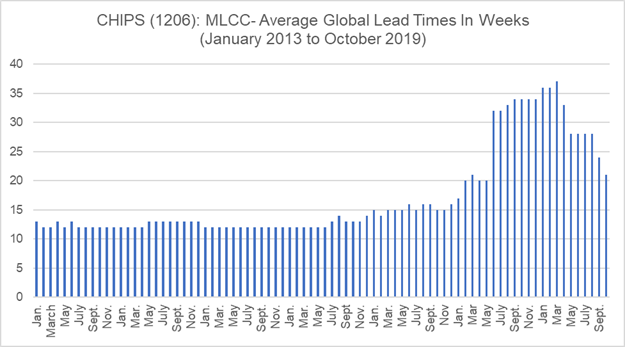
Ceramic 1210-1225 MLCC (Chips (1210-1225 BaTI02)
This range has physical dimensions of 0.12 x 0.10 to 0.12 to 0.1225 inches. This product range is manufactured from ceramic dielectric materials in a stacked dielectric and electrode configuration and terminated with solderable metal endcaps. It is used for bypass, decoupling, filtering and is a smaller product line used for value added and application specific end-markets, produced worldwide in the hundreds of millions of pieces.
It would have end-markets in defense and specialty markets. The extremely large case size chips in MLCC experienced a continued shortage and increased market demand from 2016 through 2018 with the larger case size chips in this segment also more than doubling in value during this time-period.
The market for the 1206 has relaxed substantially in October 2019 due to weakness in the end-markets, as well as capacity expansion that has been easing supply constraints.
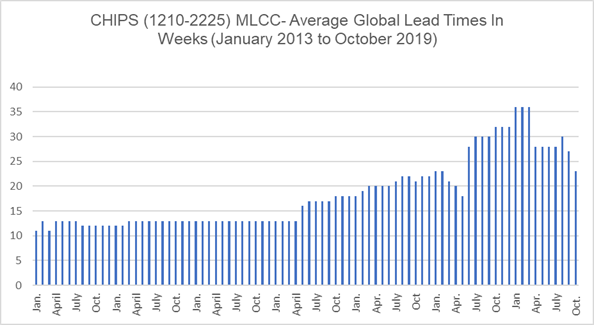
Summary and Conclusions
The MLCC market is offering mixed signals in the fourth quarter of 2019. Picofarad type MLCCs continue to show weakness amidst weak end market demand, excess inventories and new capacity, while high capacitance MLCC demand has solidified as new designs in 5G base stations and electric vehicles continue to boost the market.



















